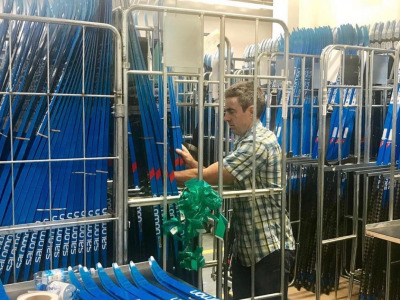Ski Selection with Zach CaldwellCaldwell Sport
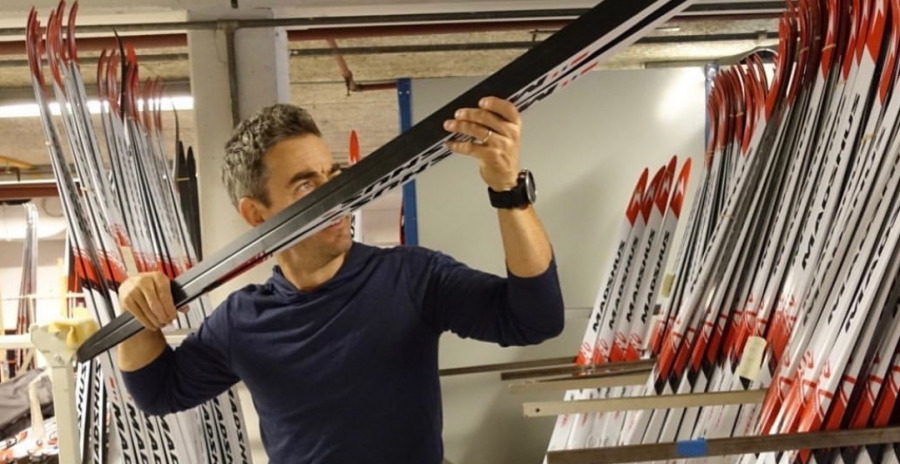
October 28, 2019
The race season is right around the corner which means if you haven’t thought about ski selection, now is the time. Finding the right kind of race skis to suit your needs takes an organized and thoughtful approach, and most of all, knowing the right people to talk to. In my opinion Zach Caldwell is one of the best resources out there especially when it comes to ski selection and grinding. Last week Zach was kind enough to share some of his expertise with NTS.
Let’s start with the basics, how many skis does a competitive ski racer need?
ZC: “At a junior level, fleet management is mostly a question of keeping up with growth and selecting skis that a growing kid can use for more than one season before going up in size. This can create an opportunity for skis to be repurposed as the skier grows – for instance, a klisters ski can be selected to become a hardwax ski when the racer gains fifteen pounds.
“Once a racer is done growing, they can begin “fleet-building” – developing a range of skis and grinds to provide optimal solutions in a wide range of conditions. We’ve all heard stories of World Cup fleets with huge numbers of skis. A “small” World Cup fleet is going to be at least twenty pairs of skis, and some skiers have far more than that. But these numbers are grossly misleading. Those fleets aren’t populated with a super-specific ski for every imaginable condition – most of the volume in those fleets is there to support the ongoing process of testing, and refining, and trying to ensure that the relatively small number of pairs that get raced with regularity are of the highest possible quality.”
So it’s better in some ways to focus on quality rather than quantity for most skiers?
ZC: “There is a tendency for racers to add new skis to their fleet to cover a perceived weakness. “My cold skis aren’t good in hard snow, so I need a hard-snow cold ski.” The result is an increasingly fractured fleet of highly specialized skis of questionable utility. It’s important to have a plan – an overarching concept for fleet development. A good example would be a simple four-pair fleet, a cold and a warm ski for both skate and classic. A different skier with more resources and support might want to expand the fleet to include a specialty ski for manmade snow, or a dedicated wet slush ski. But in general, the fleet concept should be built around broad categories and tolerant solutions.”
“It’s worth noting that the increasing prevalence of fluoro regulations in some race circuits is putting increased attention on the quality of skis and grinds. Really good wax is a great equalizer, and without that influence, the differences will be made with skis and grinds.”
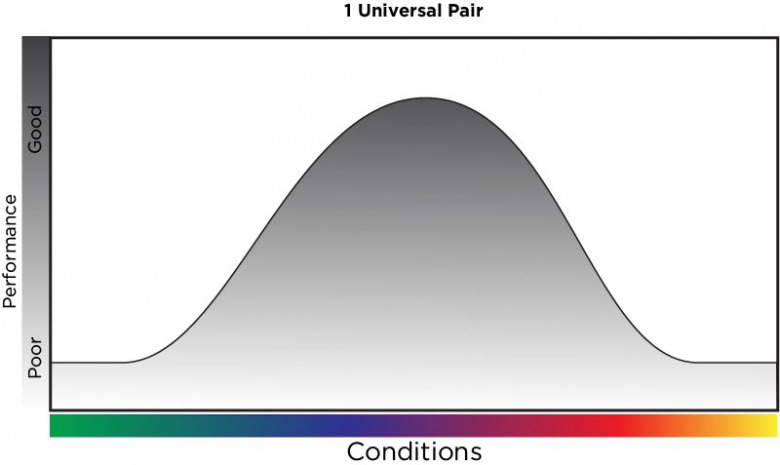

For your average high school or masters racer, is it the ski that matters most or the grind on the base?
ZC: “The conditions that a ski is best suited to are determined first by its material construction, camber, and flex characteristics. The base material is also a big factor, and it is important for the base material to be supported with appropriate camber characteristics. Finally, we can select grinds to complement these other factors and optimize the skis. There is a tendency to try to set-up skis for specific conditions by putting on a grind for those conditions. “I have this skate ski that I don’t use much, so lets grind it for really wet slush, and then I’ll have a wet slush ski.” Unfortunately this doesn’t really work. The best and widest range performance you can get out of any ski is with a grind that complements its other characteristics. If you have a broadly universal ski, you can nudge it warmer or colder with judicious grind selections. But you can’t turn a cold ski into a slush ski by grinding it for slush, unless it was never really a cold ski to start with! The best solutions are solutions where material, camber, base, and grind structure are all in harmony.”
Seems like in North America there are a ton of variable conditions that could show their face on race-day. Can a single pair of skis or a small fleet tackle all those scenarios?
ZC: “Depending on what you expect of it, a single pair of skis can do everything. Plenty of high school skiers have one pair of skis that they use in all conditions. However, it doesn’t take a very high level of competition before you’re realize the limitations of the one-pair fleet. Cold skis need to manage mechanical friction, which demands lower local pressures, release angles, and finer grinds. Wet skis need to manage adhesion/cohesion (suction) and excess moisture in the interface, which demands shorter contact areas, higher release angles, and coarser grinds. In every condition there is a trade-off between these factors – something is always being sacrificed in favor of something else. The very best single pair of skis will always have a range where it is far from the best solution.”
So, we are saying the higher level of competition the more advantageous it is for a skier to have a bigger fleet to ensure they are covered in fringe conditions. How does an athlete decide what’s right for them?
ZC: “This is the big question! I would suggest that the minimum number of skis that makes you competitive is the right number. At a World Cup level, this will be quite a few pairs, because the standard is extremely high. At a collegiate level, you are surely at a disadvantage if you’re trying to race with only one pair, but do you need six? If you’re a Birkebeiner skier, investing your vacation time and money on a trip to Hayward in February, do you want to show up for the increasingly frequent “wet” Birkie with a “normal” Birkie pair of cold skis? On the other hand, how effectively can you test and decide between four pairs, or more, with and early start and limited course access”
“Too many pairs of skis is any number that gives you brain damage on race day. If you find yourself at the race two hours before the start spreading out seven pairs of skis with all the grinds and base materials, and five hours worth of waxing invested in various base and race paraffin build-ups, then I hope you’re a very invested wax tech, and not a racer. If you’re a racer, you’ve already lost.
“There is no one right fleet concept for every racer. The set-up will depend on the competition, your resources, and the acknowledged limitations of your support system, whether that is you working alone, you working as part of a team, or you with your private personal four-person wax staff.”
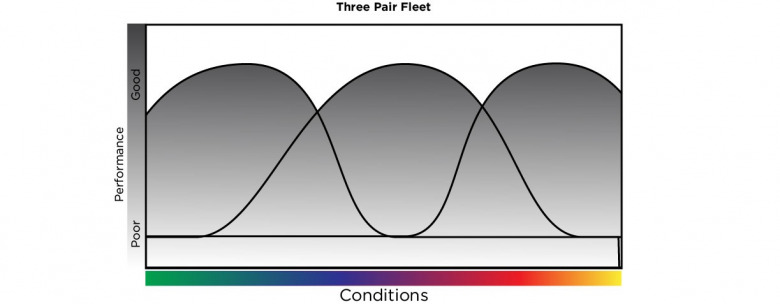
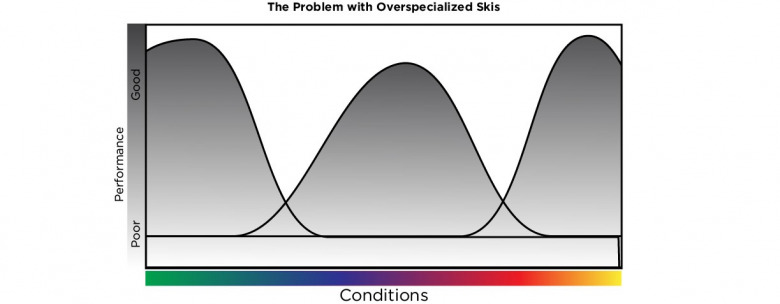
What about brands? Does it make sense to stick to one brand of ski?
ZC: “Your plan may be nudged one direction or another depending on what brand skis you use. For example, Salomon has really outstanding base materials for both specific cold and warm conditions, with a good broad range universal base positioned in between. Their ski design and camber concept is quite similar on all three models (blue, yellow, red), and is quite universal with respect to track conditions. With a three-pair fleet from Salomon, you’re likely to end up with a relatively even usage distribution among your three pairs, depending on the vagaries of the climate and the winter you end up racing in. Fischer has an outstandingly universal plus base (designated “28”), with much more narrow-range cold and wet bases available as well. Normally we focus a multi-pair fleet on cold and warm camber configurations within the plus model, 28 base skis. And the addition of cold or wet base skis would be more specialized.”
“Some base materials respond best to specific grind solutions. For instance, the Fischer cold base (A5) does best with our green-stone grinds, like G5 or TG1-1, while the clear wet base (30) does best with more rounded moderate-volume universal warm structures, but not sharp wet-specific structures.”
“It’s smart to take into consideration how your brand addresses conditions and where the opportunities lie in positioning your skis to cover all conditions to the highest level. The fact that different companies have different approaches to addressing different conditions can make it difficult to build a really simple and robust multi-brand fleet. In general, the cleanest solutions tend to be built around one brand.”
To sum things up… sounds like a large and complicated ski fleet becomes more useful the higher the level of competition and the more resources an athlete or team has on race day. More specialized ski selections can mean great skis in a very specific conditions, but they also run the risk of running poorly in more universal conditions.
Any last words of wisdom for a skier trying to elevate their fleet?
ZC: “Start simple then look for more robust selections. Avoid excessively specific solutions – look for broad range solutions with a minimum liability when they’re outside their target range (because you will pick the wrong skis occasionally).
“Instead of always looking for holes in your fleet, look for new material to replace old material.
Resist the urge to add specialty skis – instead, seek to beat your best old skis with new skis – take advantage of evolving design and keep your major solutions current. You want to be doing most of your skiing on the best skis that your brand can produce.”
For more on Zach and Caldwell Sport go to - https://www.caldwellsport.com

